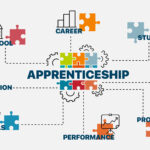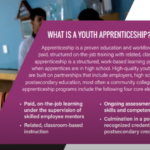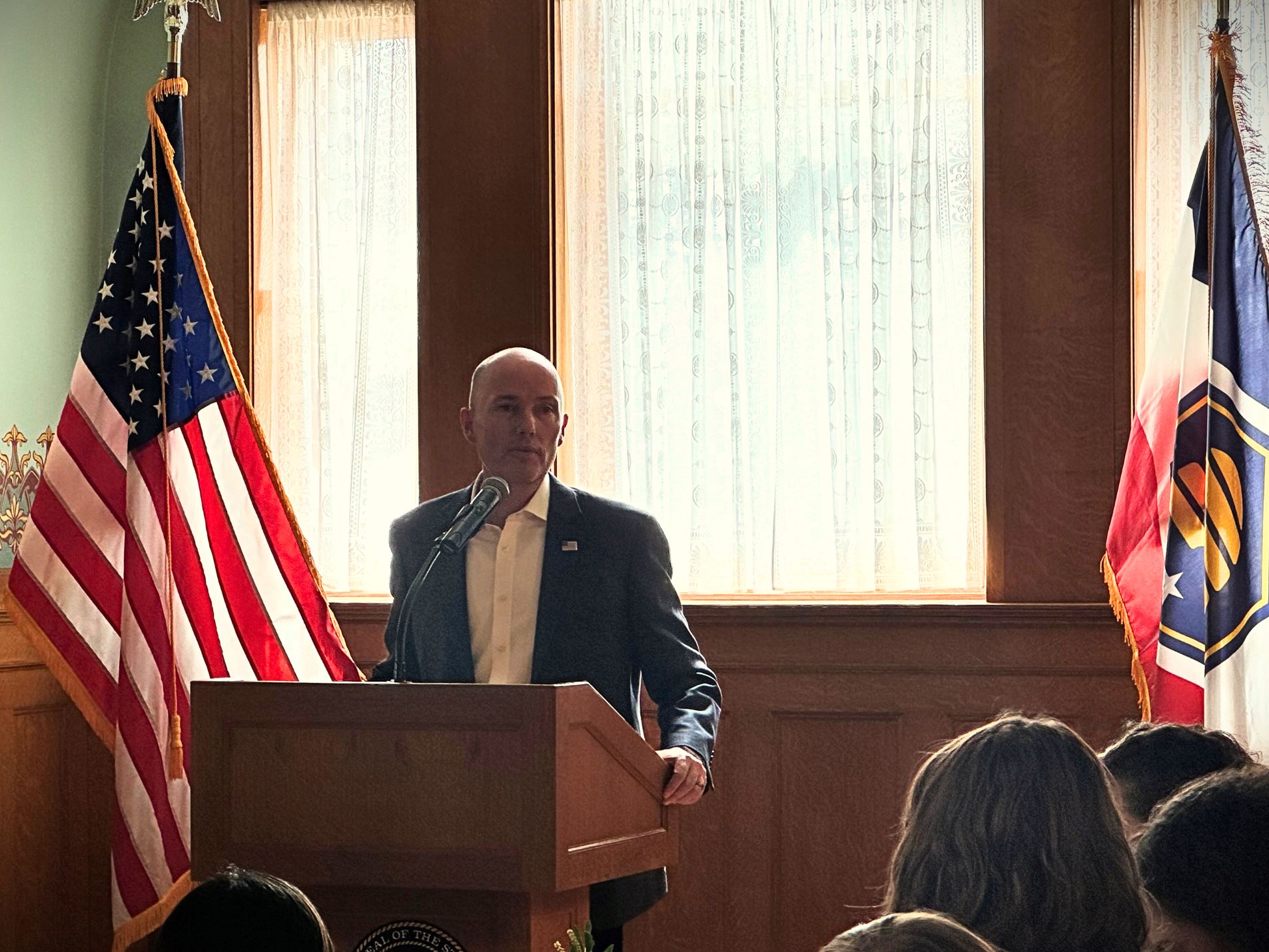Governors have the unique ability to convene and support diverse partnerships in WBL. Their WBL strategy should consider the full breadth of potential partnerships and how those partnerships can help them achieve their education and workforce goals.
(Download)
The key to success for many programs depends on effective partnership and collaboration. Indeed, in work-based learning (WBL) partnerships are not only encouraged – they’re mandatory. WBL by definition involves a partnership between business and education, with these two entities comprising the “work” and “learning.” However, policymakers and practitioners would be doing a disservice to workers and businesses alike if they saw their work as complete once those two entities are at the table. Many states have realized broader partnerships are key to make this work successful, and this resource will relay an overview of best practices in building and maintaining WBL partnerships as well as shine a light on partnerships “outside of the box” that can be pivotal to WBL success. Governors are uniquely positioned to use their convening and executive power to encourage or establish these partnerships. This resource is based on lessons learned from phase three of the National Governors Association Center for Best Practices (NGA Center) Policy Academy on Scaling Work-Based Learning, which has engaged 19 states from 2020 – 2021.
The Necessary Players
According to the NGA Center definition, “Work-based learning provides students with authentic work ex- periences where they apply and develop employability and technical skills that support success in careers and postsecondary education. Work-based learning activities culminate in an assessment and recognition of acquired knowledge and skills.” Therefore, by definition, a WBL partnership must at a minimum involve an employer and an educational entity such as a school or institution of higher education. Work-based learning programs include a continuum of activities that comprise everything from career exploration to registered apprenticeship.
Governors and other state policymakers can encourage strong partnerships between education and business through several avenues:
- Convening education and business entities to discuss their needs and seek areas of collaboration
- Incentivizing partnerships by offering funding or other resources, such as technical assistance or additional capacity, for projects involving partnerships
- Creating resources, toolkits, or guides to help education and business form strong partnerships and programs
- Growing capacity to oversee and convene WBL partnerships, such as through local or regional WBL coordinators
Examples of potential business and education partners include:
- State Departments of Education and/or Higher Education
- Two- and four-year colleges (individual and/or systems)
- School districts
- Community-based organizations, non-profits, or other entities that provide education and training
- Individual employers
- Industry associations
- Chambers of commerce
Thinking Outside of the Box
Highly successful statewide WBL initiatives include and engage a variety of partners beyond just education and business. There are numerous reasons to do so, such as increasing the ability to reach more potential students from a variety of backgrounds, or more opportunity and capability to combine funding sources, which ultimately boils down to increasing their impact and scale.
Governors have the unique ability to convene and support diverse partnerships in WBL, and they should consider the full breadth of potential partnerships in their WBL strategy and how those partnerships can help them achieve their education and workforce goals.
State teams in our Policy Academy have forged successful partnerships with many entities that states should consider in their WBL strategy, including but not limited to the following:
- Other state agencies, such as Department of Corrections, Department of Housing, Department of Health and Human Services, and/or Department of Transportation
- The public library system
- Workforce investment boards (state or local)
- Community-based organizations or non-profit organizations that provide services for specific populations (for example, ethnic and linguistic minorities, returning citizens or justice-involved individuals, people with disabilities, etc.)
- Philanthropy
- Labor unions
- Student or worker organizations
Governors often can uniquely support or encourage these partnerships by:
- Issuing executive orders that direct state agencies to examine or adopt new hiring practices that utilize WBL models such as apprenticeship and paid internships, or that encourage increasing representation of certain populations in their own workforce through WBL.
- Launching studies, committees, or other task forces that include voices from a diverse array of stakeholders and examine ways to increase WBL opportunities and partnerships throughout the state.
- Issuing proclamations that draw attention to a state WBL initiative. For example, in 2021, 42 states, territories, and the District of Columbia issued proclamations for National Apprenticeship Week and hosted events and media opportunities around apprenticeship.
State Examples
Alabama
Governor Kay Ivey called upon state agencies to lead by example and serve as apprenticeship sponsors, showing that the state truly believes in apprenticeship as a talent pipeline tool. In November 2021, the Alabama Department of Early Childhood Education became the first agency in the state to announce a registered apprenticeship program for early childhood educators. The apprenticeship will allow ap- prentices to earn stackable credentials all the way up to a bachelor’s degree while they work at a child care provider and learn on-the-job skills. Using this pilot as proof of concept, the intent is to expand to other early childhood employers and potentially launch a youth apprenticeship as well.
Nevada
Nevada recently launched Supporting and Advancing Nevada’s Dislocated Individuals, or Project SANDI for short. Project SANDI builds upon longstanding workforce and education partnerships within Nevada’s public libraries. Libraries in Nevada have hosted makerspaces for STEM learning and played a critical early role during the pandemic making medical supplies for Nevada’s health districts. They also offer on-ramps for careers in Nevada’s high demand industries through introductory courses for advanced manufacturing and VR-powered health care certifications, and have been co-located with OneStop Career Centers since 2015. In 2020, Nevada was awarded an Education Stabilization Fund – Reimagine Workforce Preparation (ESF-RWP) grant from the U.S. Department of Education to launch Project SANDI, which allowed them to build upon that strong existing foun- dation. Nevada’s Governor’s Office of Workforce Innovation (GOWINN) leads the work to provide training for in-demand jobs, including a focus on virtual reality powered career training. The public library system will work with postsecondary education institutions to host remote training sites using the latest virtual reality software and hardware.
North Carolina
LiNC-IT (Linking North Carolina with Innovative Talent) is a statewide paid internship program in North Carolina for neurodiverse individuals with Autism Spectrum Disorder (ASD). The LiNC-IT Collaborative – which includes state agencies, employers, and non-profits focused on serving those with ASD – was created under Governor Roy Cooper’s leadership to provide employment experience for young adults with autism as well as to provide employers with a pipeline of excellent talent often missed during conventional recruitment processes. Strong partnerships in the collaborative allow them to conduct all the administrative and operations work so that employers have minimal barriers to participation. The state also helps support its 16 employer partners in onboarding and retaining neurodiverse employees at no cost to the employer. Interns are guaranteed an interview with their host employers and 90% of participants have found full-time work. In addition, Governor Cooper also ensured that his own state government served as a model employer by issuing an executive order to encourage hiring of individuals with disabilities, including within state agencies.
Rhode Island
In Rhode Island, Real Skills for Youth – an initiative of the Governor’s Workforce Board – gives grants to organizations to form strategic partnerships among schools, youth-serving organizations, industry, and others to develop and implement high-quality paid WBL activities and work readiness programming for youth. As an example, grantee DownCity Design provides participating youth with design challenges from community clients. Youth work together over the course of a summer or semester to design and ultimately build structures that meet those needs. Since 2000, DownCity Design has worked with over 2,400 young designers to create 86 new structures for public spaces, including community gardens and play structures for parks and playgrounds. Through this program, youth gain valuable experience in design and construction as well as general work readiness skills like collaboration and communication.
Utah
Governor Spencer Cox signed an executive order in 2021 directing state agencies to identify new ways to provide meaningful return-to-work opportunities, remove any impediments to providing these opportunities, and offer return-to-work experiences whenever appropriate. The state then launched a pilot of Return Utah – a WBL program for those returning from extended absences from the workforce – in the summer of 2021. Participants engage in paid internships in order to add recent and relevant experience to their resumes. Lt. Gov. Henderson hosted her own “Returner” during this pilot period, as did several other state agencies. The first full cohort will begin in January 2022.
Best Practices in WBL Partnerships
States surfaced several best practices that are useful to consider when partnering with stakeholders:
- Use asset mapping and gap analysis to identify target stakeholders that can help fill existing gaps in student participation or industry representation.
- Engage stakeholders as early in the partnership as possible to build trust and create buy-in.
- Encourage existing partners to suggest potential new partnerships or bring other partners to the table.
- Start by building consensus on the basics: confirm you are aligned on definitions, goals, desired outcomes, and accountability. Reconfirm consensus at various stages as necessary.
- Be a good listener: don’t assume you know a certain stakeholder’s perspective on an issue, always ask and confirm first.
- Co-create programs, policies, and resources whenever possible. Consider co-branding when appropriate to increase buy-in and ownership.
- Seek ways to leverage each other’s unique funding opportunities and/or apply to funding opportunities as a partnership.
- Build in a feedback loop so that necessary adjustments can be made as soon as possible.
Author
Rachel Hirsch, Senior Policy Analyst, NGA Center for Best Practices.
Work-Based Learning Library

Building Systems for Success: Key Considerations for Youth Apprenticeship System Design

Advancing Apprenticeship: Opportunities For States And Business To Create And Expand Registered Apprenticeship Programs

Governors Prioritize Postsecondary Education Pathways in 2023 State of the State Addresses

How Governors are Supporting Apprenticeship, Youth Apprenticeship and Other Forms of Work-Based Learning













